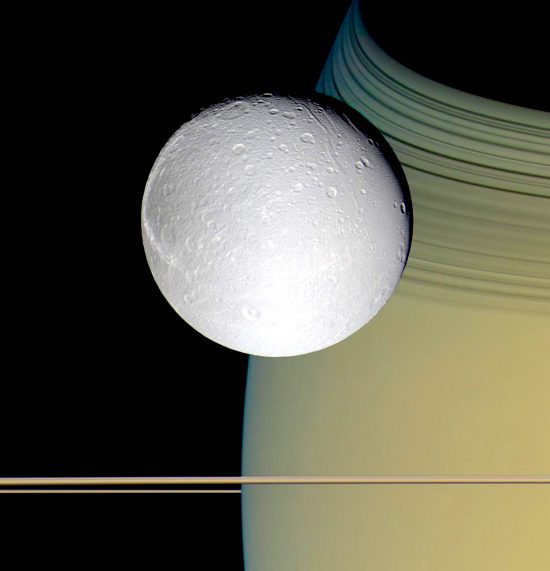
May 15, 2020
Dione is a devastated world.
Saturn’s moons hold a strong fascination; not only for their exotic beauty and weird morphology, but for the idea that they are vast lockers of frozen water. According to NASA, Saturn’s moon Dione shares a “decoupled” crust with the tiny moon, Enceladus, “floating” on a subsurface ocean.
During one of its many passes by Enceladus, Cassini’s plasma sensors found ion and electron beams propagating from Saturn’s northern hemisphere. Their variability was something of a puzzle until it was noted that time-variable emissions from Enceladus’ south polar vents corresponded with brightness variations in Saturn’s aurora.
The consensus view of astronomy sees friction and gravity affecting celestial bodies. Saturn’s gravity is thought to act like a tidal force: Enceladus is squeezed and pulled in Saturn’s gravitational grip. Its internal structure is said to stretch and compress, creating enough heat to form a liquid ocean more than 15 kilometers beneath the ice. The same “kneading” from Jupiter’s gravity is used to explain the eruptions from Europa.
As mentioned in a previous Picture of the Day, Dione is an active world, similar to Enceladus, spewing streams of particles into the plasmasphere of Saturn. On Dione, several bright cliffs are visible, wrapping around it and extending for many kilometers. In a flyby animation, the camera focuses on those features, revealing their braided shapes that often cut through craters and intersect other cliffs. Dione has no atmosphere and is only 1126 kilometers in diameter, so it was thought to be geologically inactive. Later, plumes of charged particles were found erupting from a number of hot spots on its surface.
In the Electric Universe hypothesis, those plumes are plasma discharges that are ejecting material into space, just as on Jupiter’s moon Io. It is likely that conditions existed in the past where that activity was much more energetic, forming the etched terrain that is visible today.
The grooves and canyons run parallel to each other. They have sharp rims and begin abruptly with no eroded appearance. They have side canyons running off at ninety-degree angles and craters along their lengths, often in chains. The craters are shallow with no debris around them and have central peaks similar to craters found on Earth’s Moon and on other planets, such as Mars. In past Picture of the Day articles, such formations have been identified with electric discharge machining.
Saturn’s moons orbit within its plasmasphere and exchange electrical energy with one another, so electricity must be considered whenever unusual morphology is observed. Wind and rain erode our planet and presumably create canyons and valleys. When no wind or rain exists–such as on Dione–how to explain the fresh looking and unique topography that defies convention? Should the assumption that wind and rain, alone, have sculpted the Earth also be questioned?
The Cassini spacecraft’s exploration of Saturn’s environment came to an end several years ago. However, the collected data will be analyzed for years to come. It is predicted that more details will reveal that its moons have experienced what might be called, “catastrophic” events in the past. So-called “tidal kneading” from Saturn is insufficient when considering Dione’s overall appearance and activity. Only its electrical connection with Saturn and its sister moons can explain Dione’s morphology.
Stephen Smith
The Thunderbolts Picture of the Day is generously supported by the Mainwaring Archive Foundation.












